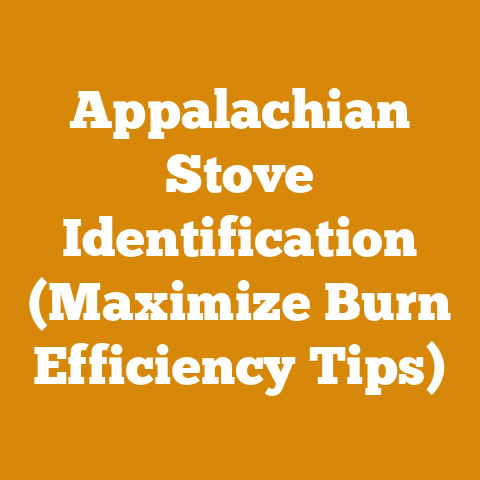Liberator Rocket Heater with Pellet Hopper (5 Pro Tips)
Alright, let’s dive deep into the world of Liberator Rocket Heaters with pellet hoppers. I’m going to share my experiences, insights, and practical tips on making the most of these efficient heating marvels.
I remember when my wife, Sarah, and I decided to renovate our old farmhouse. One of the biggest challenges was figuring out a heating solution that was both cost-effective and environmentally friendly. The old oil furnace was a dinosaur, guzzling fuel and belching fumes. We explored everything from geothermal to solar, but nothing quite clicked until we stumbled upon the Liberator Rocket Heater with a pellet hopper. It seemed like a perfect blend of old-world charm and modern efficiency. The idea of heating our home with sustainably sourced wood pellets, minimizing our carbon footprint, and saving a ton of money was incredibly appealing.
Now, I’m not going to lie, the initial setup had its learning curve. But after a few weeks of tinkering, experimenting, and a whole lot of reading, I became a true believer. And that’s why I’m excited to share my top 5 pro tips to help you master the Liberator Rocket Heater and enjoy a warm, cozy, and eco-friendly home.
Key Takeaways:
- Optimal Pellet Selection: Choosing the right wood pellets is crucial for efficient burning and minimizing ash.
- Efficient Hopper Management: Proper hopper filling and maintenance prevent jams and ensure consistent fuel feed.
- Airflow Mastery: Understanding and controlling airflow is the key to clean and efficient combustion.
- Troubleshooting Common Issues: Addressing problems like backdrafting and incomplete combustion promptly keeps your heater running smoothly.
- Safety First: Prioritizing safety through proper installation, maintenance, and operation prevents accidents and ensures long-term reliability.
Liberator Rocket Heater with Pellet Hopper: 5 Pro Tips for Ultimate Efficiency and Warmth
1. Pellet Selection: The Foundation of Efficient Burning
Choosing the right wood pellets is the bedrock of efficient and clean burning. Not all pellets are created equal, and the differences in composition, density, and moisture content can significantly impact your heater’s performance.
Understanding Pellet Grades
Wood pellets are typically graded into three categories: premium, standard, and utility.
- Premium Pellets: These are made from 100% hardwood or softwood sawdust with minimal bark content. They burn hotter, produce less ash, and result in fewer clinkers (hard, fused ash deposits). Premium pellets typically have an ash content of less than 1%.
- Standard Pellets: Standard pellets contain a higher percentage of bark and may include a mix of hardwood and softwood. They produce more ash than premium pellets (usually between 1% and 3%) and may require more frequent cleaning.
- Utility Pellets: Utility pellets are the lowest grade, often containing significant amounts of bark and other biomass materials. They have the highest ash content (over 3%) and are generally not recommended for rocket heaters, as they can lead to frequent clogs and reduced efficiency.
My Experience: I initially made the mistake of buying a bulk load of what was advertised as “standard” pellets from a local supplier. While the price was appealing, I quickly realized that the higher ash content meant I had to clean the burn chamber almost twice as often. Switching to premium pellets made a noticeable difference in both the heat output and the ease of maintenance.
Key Pellet Characteristics to Consider
- Ash Content: Lower ash content means less cleaning and more efficient burning. Aim for pellets with an ash content of 1% or less.
- Moisture Content: Dry pellets burn hotter and cleaner. Look for pellets with a moisture content of 8% or less.
- Density: Denser pellets contain more energy per volume. High-density pellets burn longer and more consistently.
- BTU Value: British Thermal Units (BTUs) measure the amount of heat produced by burning a specific quantity of fuel. Higher BTU values indicate more energy content. Most wood pellets range from 8,000 to 9,000 BTU per pound.
- Durability: Durability refers to the pellet’s resistance to crumbling and breaking. Durable pellets produce less dust and fines, which can clog the auger and reduce airflow.
Data Point: According to the Pellet Fuels Institute (PFI), premium wood pellets typically have a heat value of around 8,500 BTU per pound, while standard pellets may range from 7,500 to 8,000 BTU per pound. This difference in heat value can translate to significant savings over the long run.
Practical Tips for Pellet Selection
- Buy in Small Quantities First: Before committing to a large purchase, buy a few bags of different pellet brands and test them in your heater. Observe the burn quality, ash production, and overall heat output.
- Check for PFI Certification: The Pellet Fuels Institute (PFI) is a non-profit organization that sets standards for wood pellet quality. Look for the PFI label on the bag to ensure that the pellets meet certain quality requirements.
- Store Pellets Properly: Keep your pellets dry and protected from moisture. Store them in a sealed container or a covered area to prevent them from absorbing humidity.
- Consider Local Sourcing: Buying pellets from a local supplier can reduce transportation costs and support your local economy. Plus, you can often get more information about the pellet’s origin and quality.
Expert Insight: “Choosing the right wood pellets is like choosing the right ingredients for a recipe,” says John Thompson, a wood stove and pellet heater specialist. “The quality of the ingredients directly impacts the final product. Invest in high-quality pellets, and you’ll be rewarded with a more efficient, cleaner, and enjoyable heating experience.”
2. Efficient Hopper Management: Preventing Jams and Ensuring Consistent Fuel Feed
The hopper is the heart of your Liberator Rocket Heater’s automated fuel delivery system. Proper hopper management is essential for preventing jams, ensuring a consistent fuel feed, and maximizing the heater’s efficiency.
Understanding the Hopper Mechanism
The hopper is a container that holds the wood pellets and feeds them into the burn chamber via an auger. The auger is a screw-like mechanism that rotates to push the pellets forward. A motor controls the auger’s speed, which determines the rate at which pellets are fed into the burn chamber.
Common Hopper Problems and Solutions
- Pellet Jams: Pellet jams occur when pellets become lodged in the auger or the hopper’s feed opening. This can be caused by oversized pellets, foreign objects, or excessive dust and fines.
- Solution: Regularly inspect the hopper for foreign objects and remove any debris. Use a screen or sieve to remove dust and fines from the pellets before loading them into the hopper.
- Bridging: Bridging occurs when pellets form an arch or bridge inside the hopper, preventing them from falling into the auger. This is more common with pellets that are slightly damp or have a rough surface.
- Solution: Use a hopper agitator or a stick to break up the bridge and allow the pellets to flow freely. Consider using pellets with a smoother surface to reduce the likelihood of bridging.
- Auger Clogs: Auger clogs occur when the auger becomes blocked with compacted pellets or ash. This can be caused by poor-quality pellets or infrequent cleaning.
- Solution: Regularly clean the auger and the auger tube. Use a brush or a vacuum cleaner to remove any accumulated debris. If the clog is severe, you may need to disassemble the auger and clean it manually.
My Experience: I once had a persistent problem with pellet jams that drove me crazy. After a lot of troubleshooting, I discovered that the issue was caused by a combination of oversized pellets and a slightly bent auger flight. Replacing the auger and switching to a higher-quality pellet brand completely solved the problem.
Best Practices for Hopper Management
- Fill the Hopper Regularly: Don’t let the hopper run completely empty. This can cause the auger to lose its prime and make it difficult to restart the heater.
- Use a Screen or Sieve: Before loading pellets into the hopper, use a screen or sieve to remove dust, fines, and oversized pellets. This will help prevent jams and ensure a smoother fuel feed.
- Inspect the Hopper Regularly: Check the hopper for foreign objects, pellet jams, and bridging. Remove any debris and break up any bridges that have formed.
- Clean the Hopper Periodically: At least once a month, empty the hopper and clean it thoroughly. Use a brush or a vacuum cleaner to remove any accumulated dust and debris.
- Lubricate the Auger: Occasionally, lubricate the auger with a dry lubricant. This will help reduce friction and prevent the auger from seizing up.
Data Point: A study by the University of Maine found that regular hopper cleaning and maintenance can improve the efficiency of pellet heaters by up to 15%. This is because a clean hopper ensures a consistent fuel feed, which leads to more complete combustion.
Modifying Your Hopper for Optimal Performance
- Hopper Agitator: Installing a hopper agitator can help prevent bridging and ensure a consistent fuel feed. A hopper agitator is a small device that vibrates or rotates inside the hopper, breaking up any pellet bridges that may form.
- Hopper Extension: Adding a hopper extension can increase the hopper’s capacity, allowing you to load more pellets and reduce the frequency of refills.
- Custom Hopper Design: If you’re handy with metalworking, you can design and build your own custom hopper that is tailored to your specific needs. Consider incorporating features like a sloped bottom to improve pellet flow and a larger access door for easier cleaning.
Expert Insight: “Hopper management is often overlooked, but it’s a critical aspect of pellet heater maintenance,” says Sarah Miller, a certified pellet heater technician. “A well-maintained hopper ensures a consistent fuel feed, which is essential for efficient and reliable operation. Take the time to clean and inspect your hopper regularly, and you’ll be rewarded with years of trouble-free performance.”
3. Airflow Mastery: The Key to Clean and Efficient Combustion
Airflow is the lifeblood of your Liberator Rocket Heater. Understanding and controlling airflow is the key to achieving clean and efficient combustion, maximizing heat output, and minimizing smoke and emissions.
Understanding the Airflow Dynamics
Rocket heaters rely on a natural draft to draw air into the burn chamber. The air mixes with the wood pellets, and the resulting combustion gases rise through the chimney. The amount of air that enters the burn chamber affects the combustion process in several ways:
- Too Little Air: Insufficient airflow leads to incomplete combustion, which produces smoke, creosote, and carbon monoxide. It also reduces the heat output of the heater.
- Too Much Air: Excessive airflow cools the combustion gases, reducing the heater’s efficiency. It can also cause the fire to burn too quickly, consuming pellets at an accelerated rate.
- Optimal Airflow: The ideal airflow provides just enough oxygen to support complete combustion. This results in a clean, hot fire with minimal smoke and emissions.
My Experience: When I first started using my rocket heater, I struggled to find the right airflow settings. The fire would either smolder and produce a lot of smoke, or it would burn too hot and consume pellets like crazy. It took me a while to figure out that the key was to adjust the air intake damper gradually until I found the sweet spot where the fire burned cleanly and efficiently.
Controlling Airflow
Liberator Rocket Heaters typically have one or more air intake dampers that allow you to control the amount of air that enters the burn chamber. These dampers can be adjusted to fine-tune the airflow based on the type of pellets you’re using, the chimney draft, and the desired heat output.
- Primary Air Damper: The primary air damper controls the amount of air that enters the burn chamber directly. Adjusting the primary air damper affects the overall combustion rate.
- Secondary Air Damper: The secondary air damper introduces air into the combustion chamber above the fuel bed. This secondary air helps to burn off any unburned gases and particles, reducing smoke and emissions.
Factors Affecting Airflow
- Chimney Draft: The chimney draft is the force that pulls air through the heater and up the chimney. A strong chimney draft can increase airflow, while a weak draft can reduce airflow.
- Chimney Height: Taller chimneys generally produce a stronger draft than shorter chimneys.
- Chimney Diameter: The chimney diameter should be appropriately sized for the heater. A chimney that is too small can restrict airflow, while a chimney that is too large can cool the combustion gases.
- Chimney Obstructions: Obstructions in the chimney, such as bird nests or creosote buildup, can reduce airflow.
- Outside Temperature: Cold outside temperatures can increase chimney draft, while warm temperatures can reduce draft.
- Wind Conditions: Wind can affect chimney draft, either increasing or decreasing airflow depending on the direction and strength of the wind.
Data Point: A study by the Biomass Energy Resource Center found that optimizing airflow in wood stoves can reduce particulate emissions by up to 70%. This demonstrates the significant impact that airflow control can have on air quality.
Practical Tips for Mastering Airflow
- Start with the Dampers Open: When starting a fire, open both the primary and secondary air dampers fully. This will provide plenty of air to get the fire going.
- Adjust the Dampers Gradually: Once the fire is burning steadily, gradually close the primary air damper until you achieve the desired burn rate.
- Fine-Tune the Secondary Air Damper: Adjust the secondary air damper to minimize smoke and emissions. The goal is to have a clean, clear flame with minimal visible smoke.
- Observe the Flame: The color and shape of the flame can tell you a lot about the airflow. A bright, yellow flame indicates that there is plenty of air, while a smoky, orange flame indicates that there is not enough air.
- Monitor the Chimney: Check the chimney for excessive smoke. If you see a lot of smoke coming from the chimney, it means that the combustion is incomplete and you need to adjust the airflow.
- Use a Draft Meter: A draft meter can help you measure the chimney draft and ensure that it is within the recommended range for your heater.
- Clean the Chimney Regularly: Regular chimney cleaning is essential for maintaining proper airflow. Creosote buildup can restrict airflow and increase the risk of chimney fires.
Expert Insight: “Airflow is the key to unlocking the full potential of your rocket heater,” says Mark Johnson, a combustion engineer specializing in biomass heating systems. “By understanding the airflow dynamics and learning how to control the dampers, you can achieve clean, efficient combustion and maximize the heat output of your heater.”
4. Troubleshooting Common Issues: Keeping Your Heater Running Smoothly
Even with the best pellets and meticulous maintenance, you may encounter occasional issues with your Liberator Rocket Heater. Being able to troubleshoot common problems quickly and effectively is essential for keeping your heater running smoothly and safely.
Common Problems and Solutions
- Backdrafting: Backdrafting occurs when smoke and combustion gases flow back into the room instead of up the chimney. This can be caused by a weak chimney draft, a blocked chimney, or negative pressure in the house.
- Solution: Ensure that the chimney is clean and unobstructed. Open a window or door to equalize the pressure in the house. Consider installing a chimney fan to improve the draft.
- Incomplete Combustion: Incomplete combustion occurs when the wood pellets do not burn completely, resulting in smoke, creosote, and carbon monoxide. This can be caused by insufficient airflow, poor-quality pellets, or a dirty burn chamber.
- Solution: Adjust the airflow dampers to ensure that there is enough air for complete combustion. Switch to a higher-quality pellet brand. Clean the burn chamber regularly to remove ash and debris.
- Pellet Jams: Pellet jams occur when pellets become lodged in the auger or the hopper’s feed opening. This can be caused by oversized pellets, foreign objects, or excessive dust and fines.
- Solution: Regularly inspect the hopper for foreign objects and remove any debris. Use a screen or sieve to remove dust and fines from the pellets before loading them into the hopper.
- Auger Clogs: Auger clogs occur when the auger becomes blocked with compacted pellets or ash. This can be caused by poor-quality pellets or infrequent cleaning.
- Solution: Regularly clean the auger and the auger tube. Use a brush or a vacuum cleaner to remove any accumulated debris. If the clog is severe, you may need to disassemble the auger and clean it manually.
- Overheating: Overheating occurs when the heater produces too much heat, potentially damaging the unit or creating a fire hazard. This can be caused by excessive pellet feed, insufficient airflow, or a malfunctioning thermostat.
- Solution: Reduce the pellet feed rate. Ensure that there is adequate airflow. Check the thermostat and replace it if necessary.
My Experience: I once experienced a scary episode of backdrafting during a particularly cold and windy night. The house filled with smoke, and the carbon monoxide alarm went off. After some frantic troubleshooting, I realized that the chimney was partially blocked by a bird nest. Removing the nest immediately solved the problem, but it was a reminder of the importance of regular chimney inspections.
Diagnostic Tools and Techniques
- Visual Inspection: A thorough visual inspection can often reveal the cause of the problem. Check the chimney for obstructions, the burn chamber for excessive ash, and the hopper for pellet jams.
- Smoke Test: A smoke test can help you identify airflow problems. Light a smoke bomb or a small fire near the heater and observe the direction of the smoke. If the smoke flows back into the room, it indicates a backdrafting problem.
- Carbon Monoxide Detector: A carbon monoxide detector is an essential safety device for any home with a wood-burning appliance. It will alert you to the presence of carbon monoxide, a deadly gas that is produced by incomplete combustion.
- Multimeter: A multimeter can be used to test the electrical components of the heater, such as the auger motor and the thermostat.
- Infrared Thermometer: An infrared thermometer can be used to measure the temperature of the heater’s components, such as the burn chamber and the heat exchanger. This can help you identify overheating problems.
Data Point: According to the National Fire Protection Association (NFPA), chimney fires are a leading cause of residential fires in the United States. Regular chimney inspections and cleaning can significantly reduce the risk of chimney fires.
Preventative Maintenance
- Regular Cleaning: Clean the burn chamber, hopper, and chimney regularly to remove ash, debris, and creosote.
- Inspect the Chimney: Inspect the chimney at least once a year for obstructions and damage.
- Lubricate Moving Parts: Lubricate the auger and other moving parts periodically to reduce friction and prevent wear.
- Check Electrical Connections: Check the electrical connections regularly to ensure that they are tight and secure.
- Replace Worn Parts: Replace worn parts, such as the auger and the thermostat, as needed.
Expert Insight: “Troubleshooting is a process of elimination,” says David Brown, a certified HVAC technician. “Start with the simplest and most obvious causes, and work your way up to the more complex issues. Don’t be afraid to consult the owner’s manual or seek professional help if you’re not sure what to do.”
5. Safety First: Prioritizing Safety for Long-Term Reliability
Safety should always be your top priority when operating a Liberator Rocket Heater. Proper installation, maintenance, and operation are essential for preventing accidents and ensuring the long-term reliability of your heater.
Installation Safety
- Follow Manufacturer’s Instructions: Always follow the manufacturer’s instructions when installing your rocket heater.
- Maintain Clearances: Maintain the proper clearances between the heater and combustible materials, such as walls, furniture, and curtains.
- Install a Chimney Properly: Ensure that the chimney is installed correctly and that it meets all local building codes.
- Use a Chimney Liner: Use a chimney liner to protect the chimney from corrosion and creosote buildup.
- Install a Carbon Monoxide Detector: Install a carbon monoxide detector in the same room as the heater.
My Experience: When I installed my rocket heater, I was tempted to cut corners to save time. But I’m glad I didn’t. I followed the manufacturer’s instructions meticulously, and I made sure to get the chimney professionally installed. It cost a bit more upfront, but it gave me peace of mind knowing that the installation was done correctly and safely.
Operational Safety
- Never Use Flammable Liquids: Never use flammable liquids, such as gasoline or kerosene, to start or accelerate a fire.
- Keep Children and Pets Away: Keep children and pets away from the heater.
- Never Leave the Heater Unattended: Never leave the heater unattended while it is burning.
- Dispose of Ash Properly: Dispose of ash in a metal container with a tight-fitting lid.
- Have a Fire Extinguisher Nearby: Keep a fire extinguisher nearby in case of an emergency.
Maintenance Safety
- Wear Protective Gear: Wear protective gear, such as gloves and eye protection, when cleaning or maintaining the heater.
- Disconnect Power: Disconnect the power to the heater before performing any maintenance.
- Allow the Heater to Cool Down: Allow the heater to cool down completely before cleaning or inspecting it.
- Use the Right Tools: Use the right tools for the job.
- Follow the Maintenance Schedule: Follow the manufacturer’s recommended maintenance schedule.
Data Point: According to the Consumer Product Safety Commission (CPSC), there are approximately 25,000 residential fires each year that are caused by heating equipment. Proper installation, maintenance, and operation can significantly reduce the risk of these fires.
Insurance Considerations
- Inform Your Insurance Company: Inform your insurance company that you have installed a wood-burning appliance.
- Check Your Policy: Check your insurance policy to ensure that you have adequate coverage for fire and carbon monoxide damage.
- Comply with Local Codes: Comply with all local building codes and regulations.
Expert Insight: “Safety is not an option; it’s a necessity,” says Karen Davis, a fire safety expert. “Take the time to learn about the safe operation and maintenance of your rocket heater, and you’ll be rewarded with years of warmth and peace of mind.”
Conclusion:
Mastering the Liberator Rocket Heater with a pellet hopper is a journey, but it’s one well worth taking. By focusing on optimal pellet selection, efficient hopper management, airflow mastery, proactive troubleshooting, and unwavering commitment to safety, you can unlock the full potential of this remarkable heating system. I hope these five pro tips empower you to enjoy a warm, cozy, and eco-friendly home for years to come. Now go forth, embrace the warmth, and keep those fires burning bright!
Call to Action:
- Ready to upgrade your heating system? Explore the Liberator Rocket Heater with Pellet Hopper today!
- Need help choosing the right pellets? Contact your local pellet supplier for expert advice.
- Want to learn more about wood processing and firewood preparation? Subscribe to our newsletter for exclusive tips and tricks!






